
Nevsky Prospekt is the main thoroughfare and one of the most popular streets in St. Petersburg, which has a rich history.
The length of Nevsky Prospekt is about 4.5 kilometers. It crosses the historical part of St. Petersburg from the north-west to the south-east-from Alexander Garden (Palace Square and Admiralteiskiy Prospekt) to Alexander Nevsky Square (Alexander Nevsky Lavra).
Today, Nevsky Prospekt is home to a large number of attractions, including historic buildings, palaces, squares, gardens, cathedrals, and bridges. Learn more about Nevsky Prospekt…
This article describes the most interesting and impressive sights of Nevsky Prospekt (what to see on Nevsky, where to go on Nevsky), many of which are included in the top attractions of the city of St. Petersburg.
The Wawelberg House (Saint Petersburg Commercial Bank) is a former apartment building and commercial bank.
The building was built in 1910 for the St. Petersburg Merchant Bank. The customer of the construction was Mikhail Ippolitovich Wawelberg-the heir of the founder of the St. Petersburg Merchant Bank (1846)-the merchant of the first guild of Hirshem Wawelberg.
The building was built according to the project of the architect Marian Marianovich Peretyatkovich.
The Neo-Renaissance building stands out among the surrounding buildings, attracting attention with its massiveness and dark color, which give the impression of the heaviness of the structure. More about Wawelberg House…
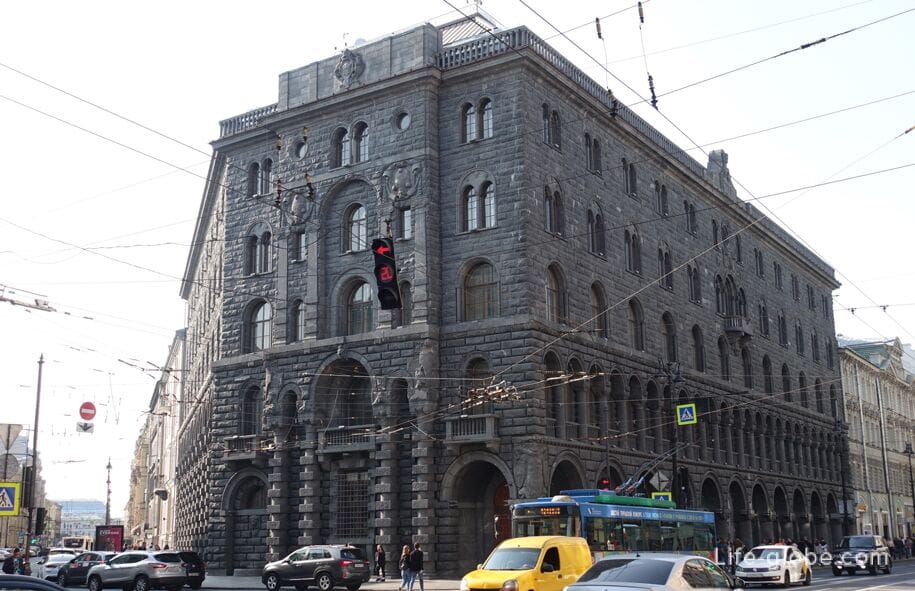
The Chicherin Palace, also known as the Yeliseyev Palace , is a former mansion built by 1771 as a palace-mansion in the style of early classicism for the Police Chief General Nikolai Ivanovich Chicherin.
In 1789, due to debts, Chicherin's son, Alexander, sold the house to Prince Alexey Borisovich Kurakin, who commissioned an apartment building to be added to the mansion in 1794.
Subsequently, the building changed several owners and residents, and another building was added to it.
In 1858, the complex of buildings became the property of the Yeliseyev brothers. At the same time, the reconstruction of the building was carried out according to the project of the architect N. P. Grebenka.
After the 1917 revolution, the Yeliseyevs were forced to emigrate, and their home was nationalized.
In 2003, after a major reconstruction of the buildings, the grand opening of the 5-star Talion Imperial Hoteltook place , which, to this day, is located in a complex of buildings. Guided tours are also available in the premises of the former mansion. Read more about the house-palace of the Eliseevs…
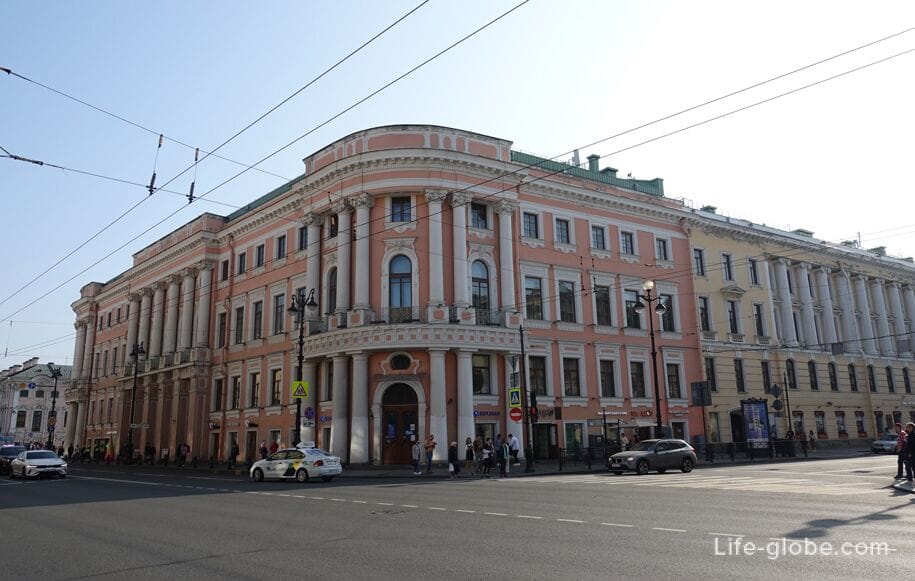
Stroganov Palace (Stroganov Palace) is a former palace and occupies a corner on Nevsky Prospekt and the Moika River embankment.
The formation of the palace began in the 1720s, when one-story chambers belonging to the Stroganov family were built.
As a palace, the Stroganov estate was built in 1753-1754, when the architect of Italian origin Francesco Bartolomeo Rastrelli united the Stroganov houses into a single whole with a common facade belonging to the Baroque style.
In the late 18th and early 19th centuries, Andrey Voronikhin reconstructed and re-created a number of interiors of the palace in the classical style, including in the newly added buildings.
After the revolution, in 1918, the Stroganov Palace was nationalized.
Since 1988, the building has been transferred The Russian Museum. Today, in the walls of the Stroganov Palace, you can see some restored rooms and halls. Learn more about the Stroganov Palace…
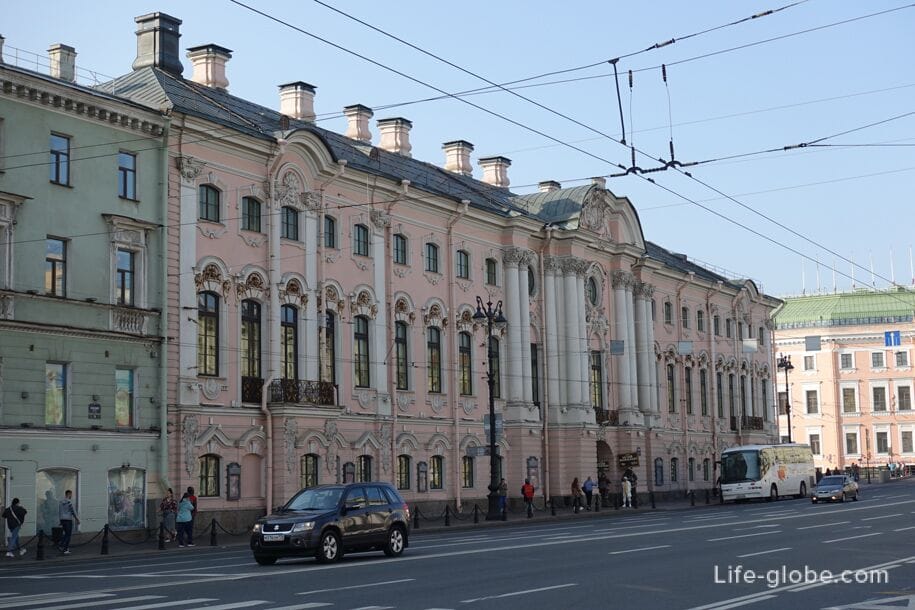
The House of the Dutch Reformed Church or simply the Dutch Church is a former church of the Dutch Reformed Church.
The church building was built in 1831-1835 by the French-born architect Pavel Jaco in the style of Russian classicism on the site of a house owned by the Dutchman Pierre Puzy.
After the revolution of 1917, in 1926, services were discontinued, and the church building was nationalized and housed various organizations.
Currently, the building houses, among other things, residential apartments, commercial premises and the Center for Art and Music of the Mayakovsky Central State Library. More about the house of the Dutch Reformed Church…
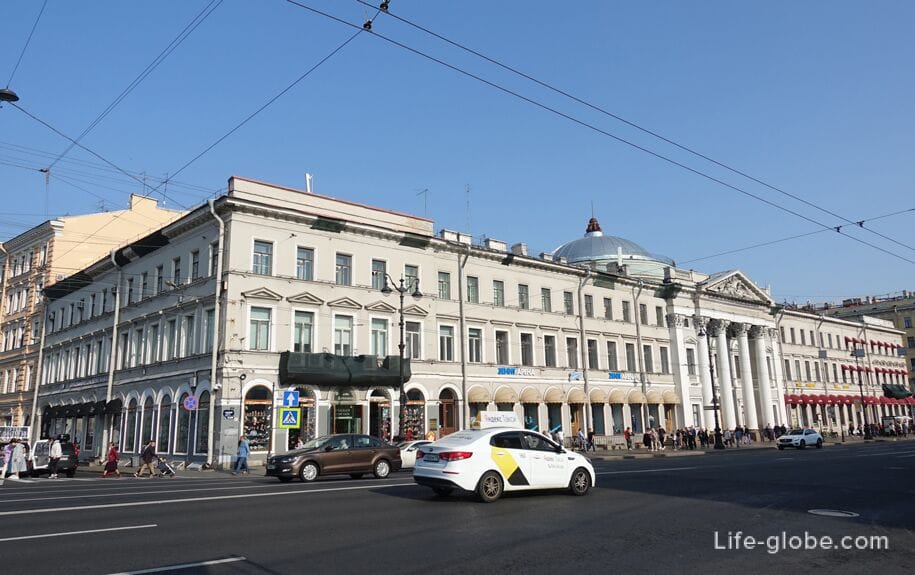
The Mertens House is a historic building and architectural monument, which is one of the first neoclassical monuments in St. Petersburg.
The current building was built in 1911-1912 by order of F. L. Mertens as a trading house of the Mertens fur company.
Today, the building houses a restaurant and a Zara store. More about Mertens House…
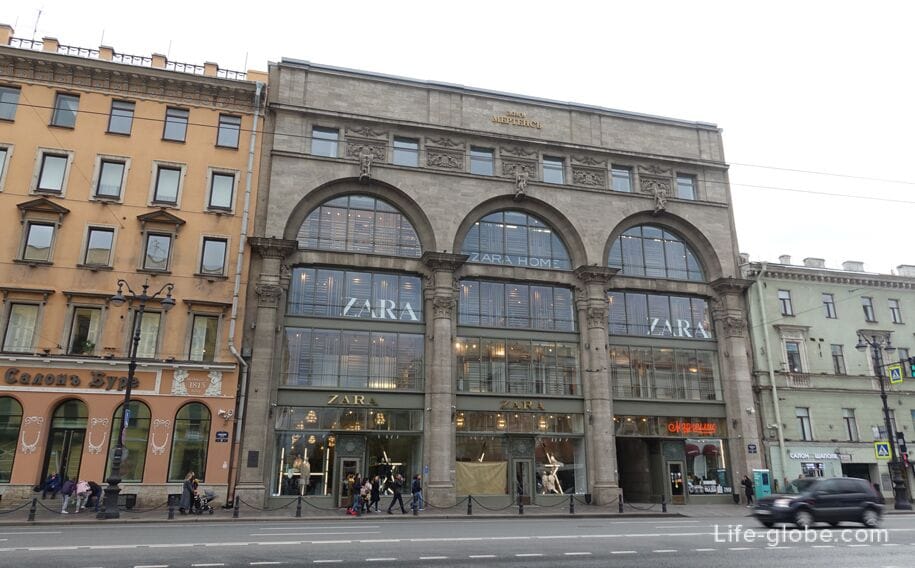
The Lutheran Church of Saints Peter and Paul (Petrikirche) in St. Petersburg is the largest Evangelical Lutheran church in Russia.
The Church of Saints Peter and Paul hosts services, guided tours, including the catacombs of the Petrikirche, exhibitions and cultural events. The church has organs.
The current building of the church is the second, and was built in the period from 1833 to 1838 by the architect and artist Alexander Pavlovich Bryullov. Subsequently, the facades and interiors of the church were subjected to restorations and artistic additions.
Today, the Petrikirche is a functioning Lutheran church. It has classic features with two symmetrical square towers. Learn more about the Petrikirche Ensemble…
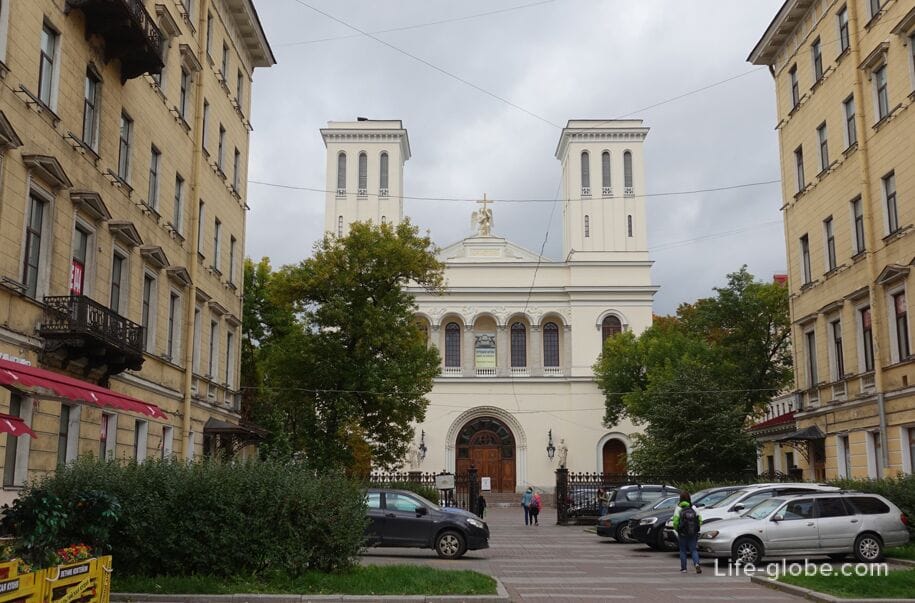
Kazan Cathedral (Cathedral of the Kazan Icon of the Mother of God) is one of the largest churches in St. Petersburg.
The cathedral is a cathedral.
The Kazan Cathedral was built from 1801 to 1811, according to the idea of Emperor Paul I, on the site where the modest Church of the Nativity of the Virgin was located, which housed one of the main St. Petersburg shrines - the miraculous icon of the Kazan Mother of God.
Today, the Kazan Cathedral is an outstanding monument of Russian history, architecture and fine arts.
An integral part of the interior of the cathedral is painting. The iconostasis of the cathedral was painted by the best artists of the late 18th and early 20th centuries.
The main shrine of the cathedral is the venerated image of the Kazan Icon of the Mother of God. Learn more about Kazan Cathedral…
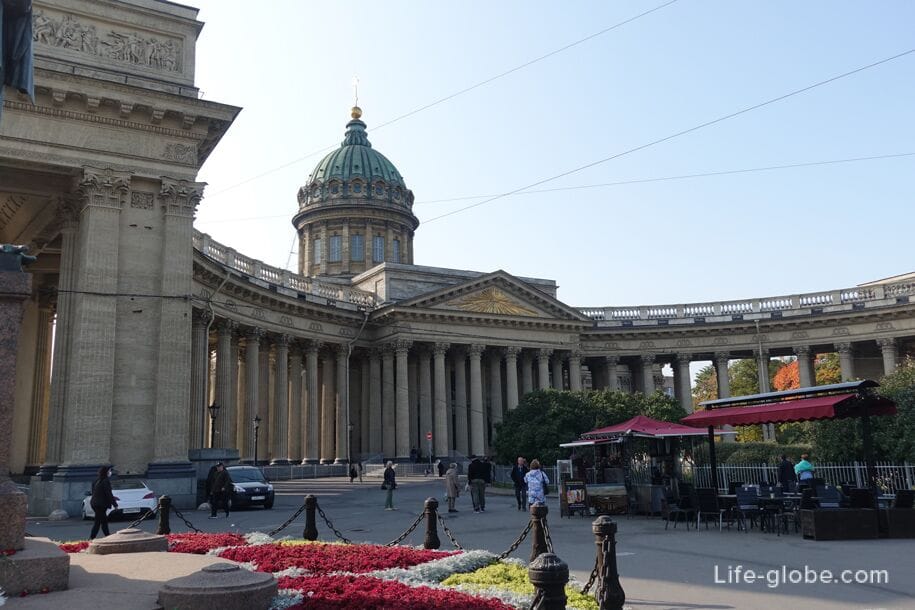
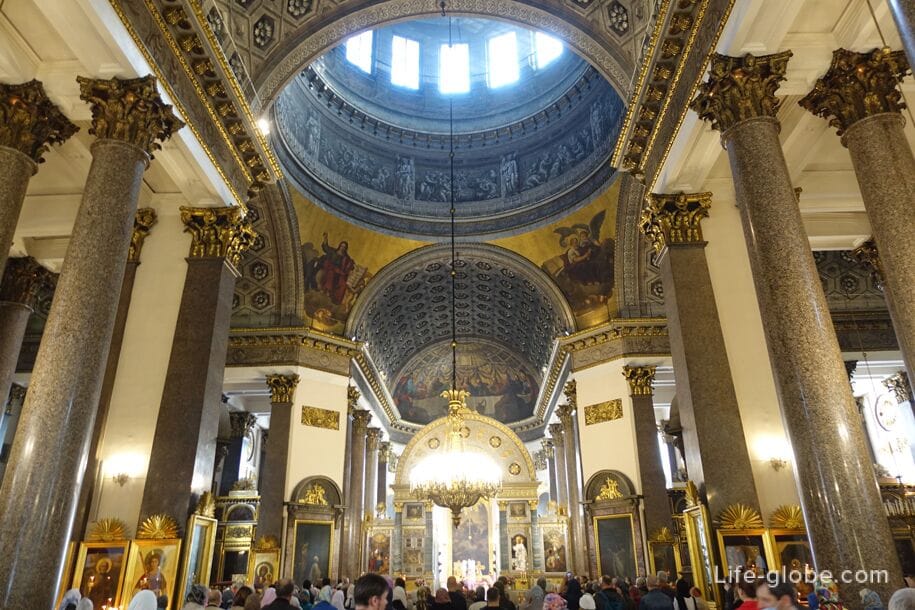
The Singer House, also known as the" House of Books", is a famous historical building that is one of the symbols of St. Petersburg.
The building was built in 1902-1904 by architect Pavel Suzor for the "Singer Joint Stock Company in Russia". The building was owned by the Singer company until 1917.
In 1938, the "House of Books" was opened in part of the building.
Today, this corner building, facing Nevsky Prospekt and the embankment of the Griboyedov Canal, stands out in the Art Nouveau style with neo-Baroque elements and numerous decorations on the facades. The upper central part of the building is crowned by a large glass dome, on which two female figures hold a "globe".
Within the walls of the building are located: the House of Books, the cafe "Singer" and premises for rent. There are also guided tours of the building, which include access to the Krusha, which offers panoramic views. More about the Singer House…

The building of the City Duma, the tower of the City Duma and the Silver Rows is a complex of buildings (buildings), which is an architectural monument of federal significance.
The City Council building was built as a Guild house in 1752-1754. Since 1786, the building also housed the St. Petersburg City Duma.
Next to the Guild House, in the same style, there were Silver Rows - trading rows for trading in silver and precious stones. The silver rows burned down in 1783. In 1784-1787, the architect Giacomo Quarenghi erected the building of the "Silver Rows"that has survived to this day.
In 1799, by the decree of the Emperor Paul I, the guild house was transferred to the city administration. At the same time, Paul I ordered the construction of a signal tower on the corner, in case of fire or flood - - today it is the tower of the City Duma.
The Tower of the City Duma is available for visiting. The most interesting thing about the tower is the open 360-degree observation deck, which, for a fee, can be climbed up a spiral staircase and from which one of the best opens in the city panoramic views of the center of St. Petersburg. Learn more about the complex of buildings…
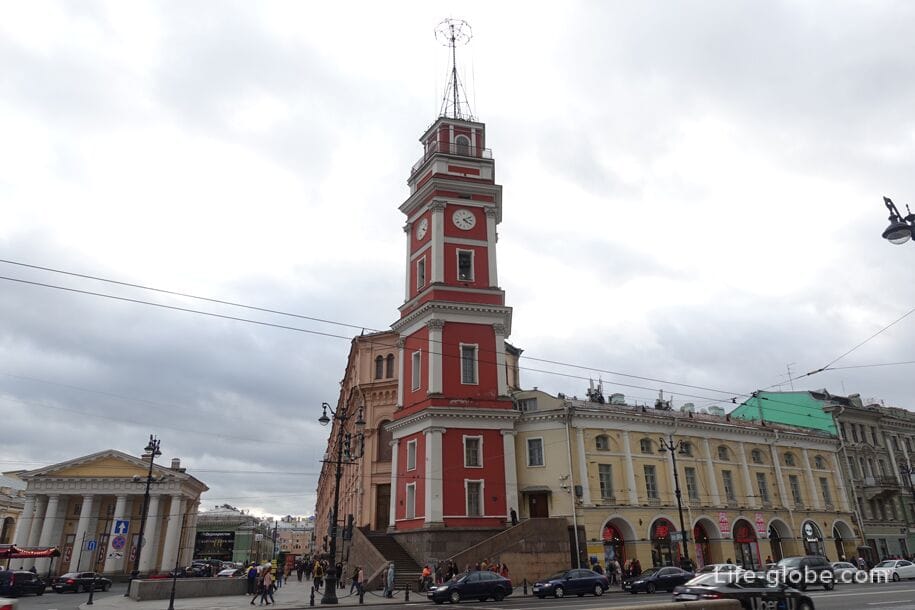
The Basilica of St. Catherine of Alexandria is a Catholic church, which is the oldest in the city and one of the oldest churches of the Roman Catholic Church in Russia.
The church was built in 1763-1783 in the style of early classicism.
Adjacent to the basilica are two symmetrical former apartment buildings built in the classical style. The houses with the basilica are connected by arches. Learn more about the Basilica of St. Catherine of Alexandria...
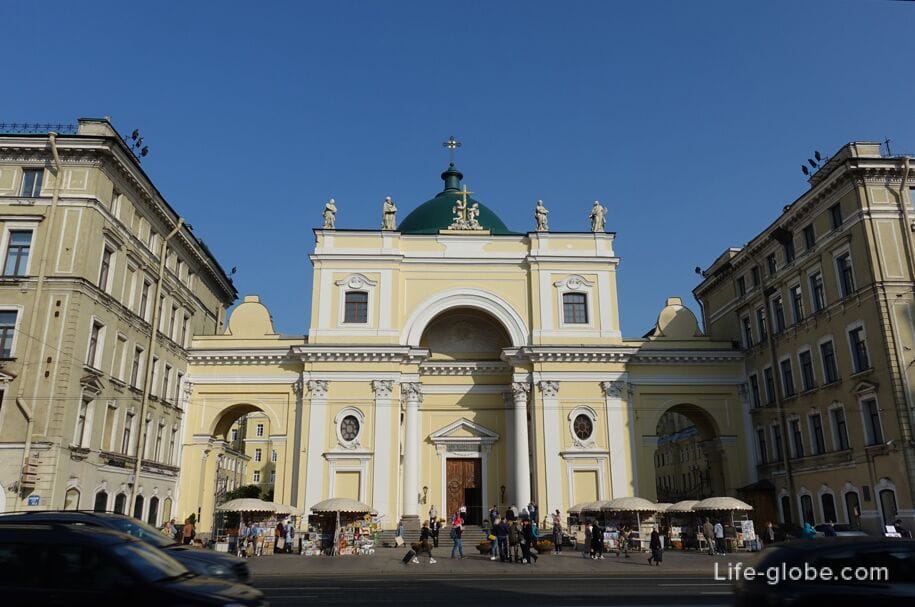
Bolshoy Gostiny Dvor is a historical shopping department store, which is a monument of history and architecture of the 18th century.
The history of Gostiny Dvor is closely connected with the formation of the city, when Gostiny Dvor was conceived by decree of the Empress Elizabeth Petrovna as the largest retail space in the Russian Empire.
Construction lasted from 1761 to 1785, designed by the French architect Jean-Baptiste-Michel Vallin-Delamotte, who built the building in the style of early classicism.
Subsequently, the facades of the Gostiny Dvor were modified.
Today, Bolshoy Gostiny Dvor, as well as many years ago, is a shopping place - the largest and most famous department store in the city. Learn more about Bolshoy Gostiny Dvor…
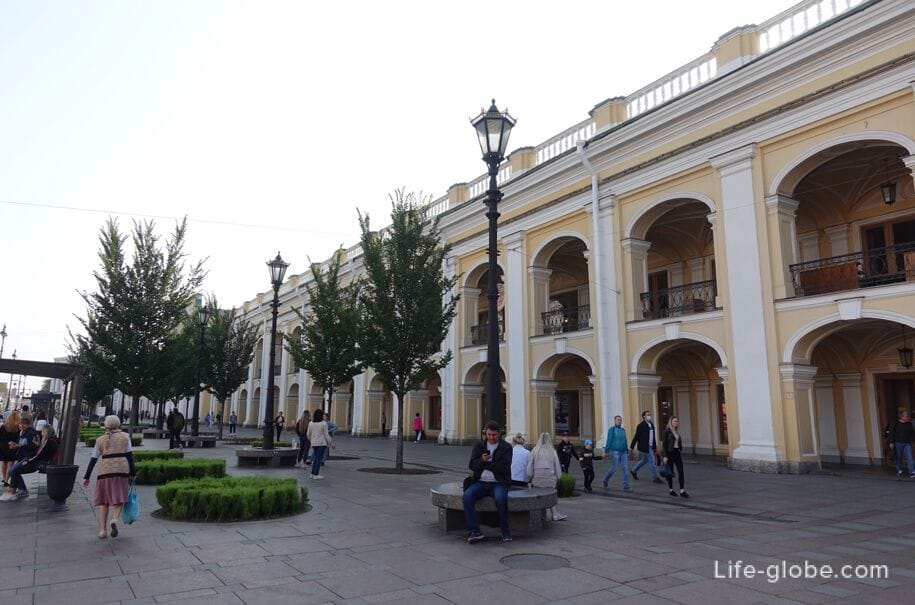
Belmond Grand Hotel Europe (Belmond Grand Hotel Europe) - the luxury hotel, which is one of the best in the city, has 5 stars and is located in a historic building with a corner facade facing Nevsky Prospekt.
The building was built in the late 18th century. In 1823-1825, the old house was rebuilt and new stone houses were built on the site. Another reconstruction, designed by K. I. Rossi, took place in 1826-1830.
In the second half of the 19th century, the buildings were converted into a hotel, in an eclectic style. Subsequent alterations, superstructures and redevelopments of the building were also carried out. The building was used for various purposes, until in 1945, after repairs, it began to function again as a hotel.
Other facilities atthe hotel include a concierge service, a bar, a fitness center, a spa and wellness center, free Wi-Fi and parking, facilities for disabled guests, a tour desk, an ATM and conference rooms.
A buffet breakfast can be included in the room rate. Link to the hotel
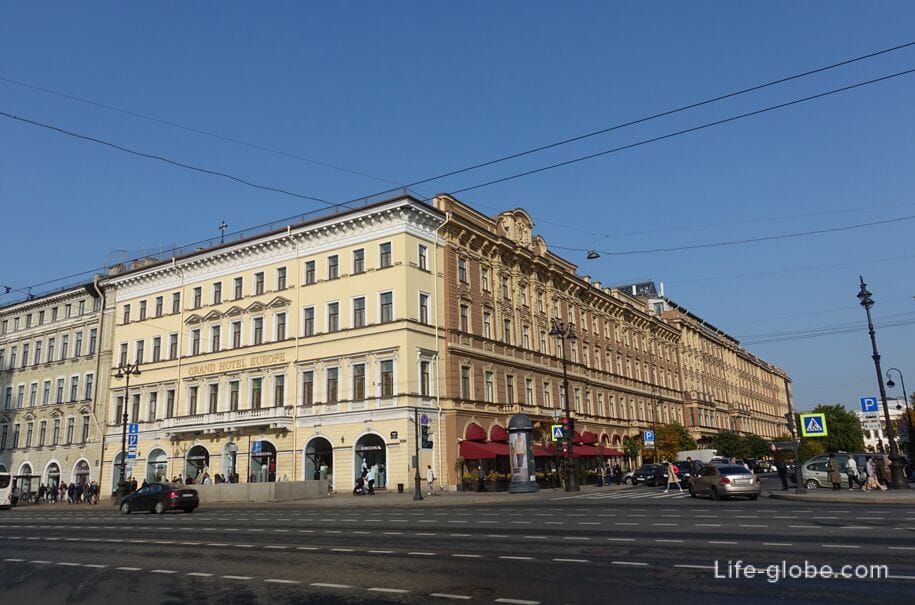

St. Catherine's Church is a church of the Armenian Apostolic Church in St. Petersburg, which is an architectural monument.
The church was built in 1771-1779 by architect Yuri Matveevich Felten.
The style of the church is made in the traditions of early Russian classicism.
The main facade of the church is marked by a strict columned portico, in the pediment of which there is a sculptural relief with a story from the history of Armenia: "Catholicos Grigor the Illuminator performs the baptism of King Trdat III".
The facade of the church is also distinguished by the architectural decoration of the windows, pilasters with elegant capitals and a towering domed tower with a cross. Learn more about St. Catherine's Armenian Church…
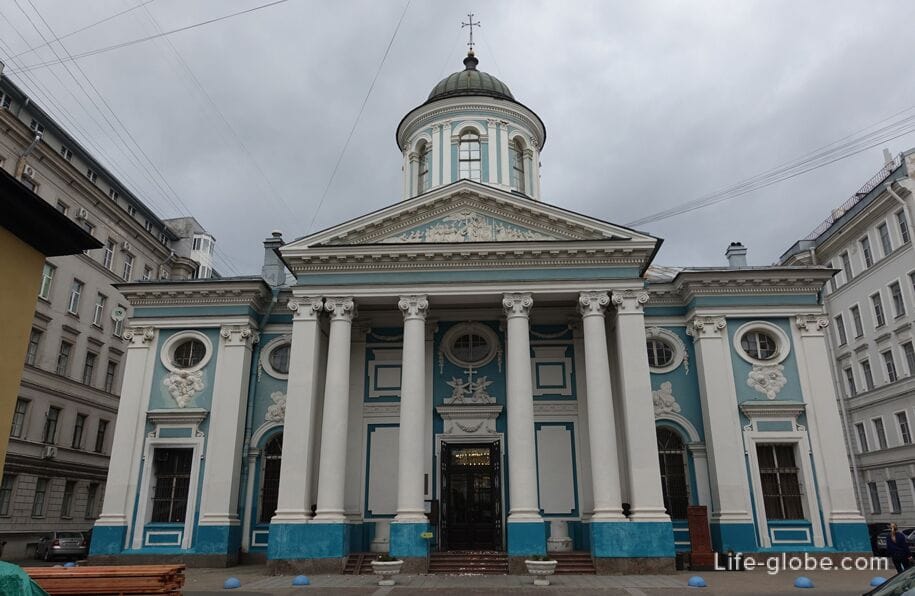
The Grand Palace (formerly the Siberian Merchant Bank building) is a historic building that today houses the Grand Palace Boutique Gallery.
The first three-storey house on this site was built in 1778 for the valet N. S. Kozlov. In 1779, the house was added to the fourth floor, and in 1858-the fifth.
In the 1880s-1900s, the site belonged to the insurance company "Russia".
In 1907, the building came into the possession of the Siberian Merchant Bank, for which it was completely rebuilt.
From 2003 to the present, the building houses the Grand Palace Boutique Gallery, which, in addition to boutiques, has a cinema, a beauty salon, a restaurant and a cafe.
Featuring free Wi-Fi, free private parking, a fitness centre and a 24-hour front desk, Majestic apartment on Nevsky, 44 offers self-catering accommodation. Learn more about the Grand Palace Gallery»…
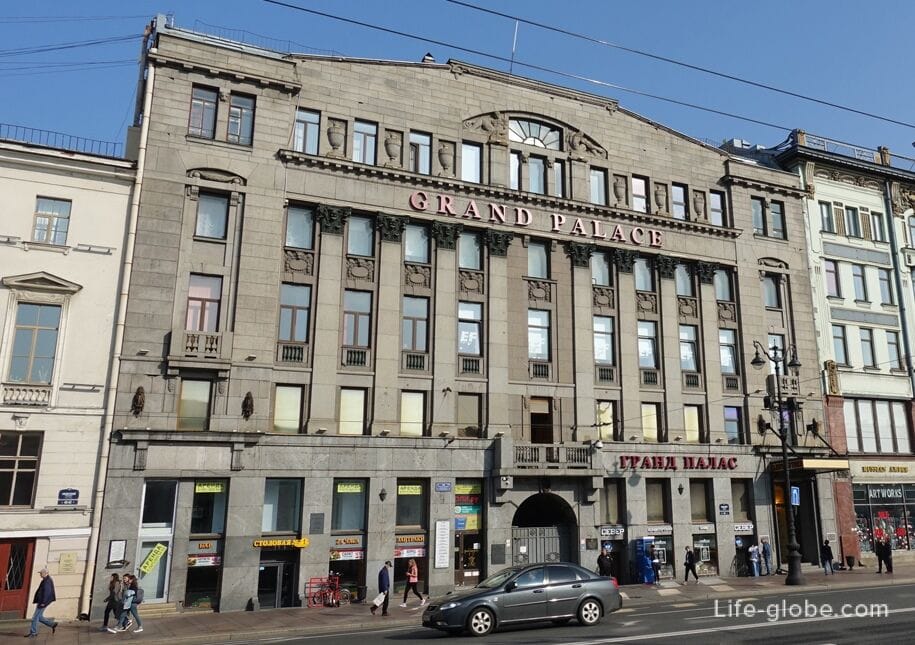
The house on this plot was built in 1745-1746 by the architect M. G. Zemtsov for the coffeeshop of the Empress Elizabeth Petrovna-Alexander Ulyanovich Sablukov.
Subsequently, the owners of the house changed, and the building was rebuilt.
The current building was built in 1901-1902 by the architect Leontius (Ludwig) Nikolayevich Benois for the St. Petersburg branch of the Moscow Merchant Bank.
The house of the Moscow Merchant Bank became the first Art Nouveau building on Nevsky Prospekt.
Currently, the building has a Dental clinic No. 1 and a large store of the book retail chain "Bukvoed".
The building is designed in the style of South Slavic Art Nouveau. Read more about the building of the Moscow Merchant Bank…
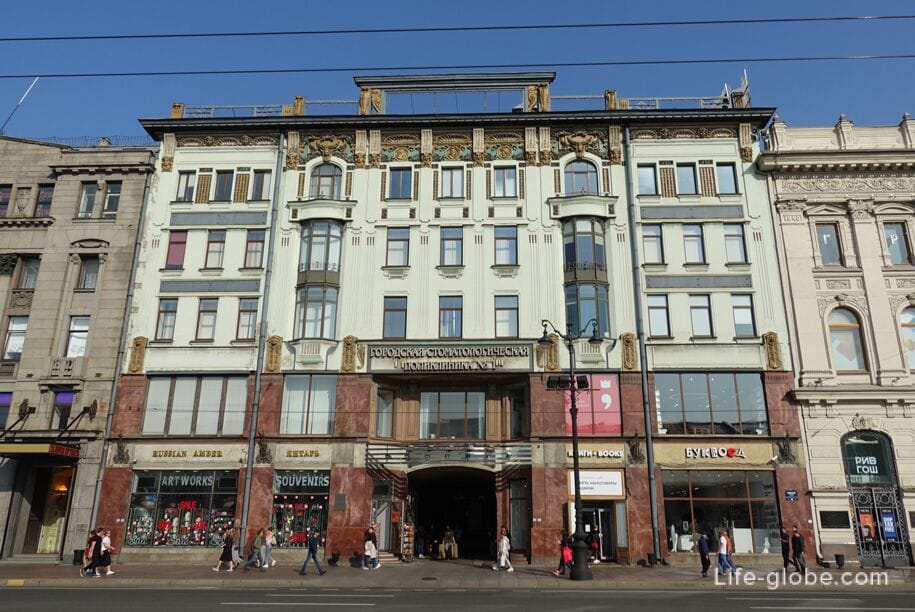
Passage is a historical shopping house (shopping gallery), which is one of the oldest and largest shopping centers in St. Petersburg.
The building was built by order of the collegiate adviser Count Yakov Ivanovich Essen-Stenbock-Fermor, designed by architect Rudolf Andreevich Zhelyazevich in 1846-1848, not only as a trading house, but also as a center of cultural and social life of the capital.
In the late 18th and early 19th centuries, the building was rebuilt by architect Sergei Kozlov at the behest of its new owner, Princess N.A. Baryatinskaya. The passage became four-storeyed, and the entrance two-column portico was added to the main facade facing Nevsky Prospekt.
Today, the Passage is a well-known shopping center, within the walls of which there are shops, salons, boutiques, cafes and restaurants. Learn more about the Passage…
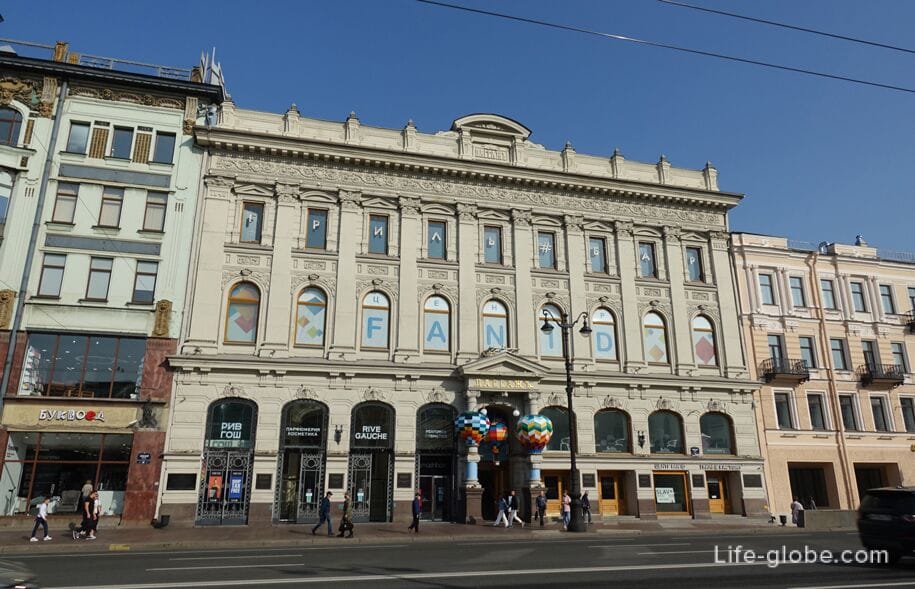

The Russian National Library (RNB) is one of the first public libraries in Eastern Europe and the oldest national library in Russia, consisting of several buildings in St. Petersburg.
Initially, in 1796-1801, on the corner of Nevsky Prospekt and Sadovaya Street, the architect Yegor Sokolov designed the first special building in Russia designed to house a library.
By 1832, according to the project of Rossi, another building was added to the existing Sokolov building.
Today, both buildings are part of the main library complex. Learn more about the Russian National Library…

The history of the square dates back to the middle of the 18th century, when the land of the Anichkov Palace was listed on this place.
The formation of a full-fledged square began with the construction of the nearby Alexandrinsky Theater (1832) - when part of the land of the palace (the western part of the garden) was allocated as a separate unit for the arrangement of the territory in front of the theater.
Today, Ostrovsky Square is an architectural complex that remains one of the highest achievements of Russian urban planning art.
On the square there are: Catherine's Garden with a monumental monument to Catherine II, Alexandrinsky Theater with a museum, buildings of the Ministry of Public Education and the Directorate of the Imperial Theaters, the house of Basin, the building of the city credit society, the building of the Russian Musical Society, the monument to the janitor, etc. Learn more about Ostrovsky Square…

Anichkov Palace - one of the former imperial palaces-now a monument of Russian architecture of the 17th and 19th centuries.
The palace was erected starting in 1741 by the decree of the Empress Elizabeth Petrovna.
In the garden of the Anichkov Palace there are two pavilions built by K.I. Rossi in 1817-1818.
The palace itself consists of several buildings, which today are: the theater and concert complex "Carnival", the St. Petersburg City Palace of Youth Creativity, the library and the Anichkov Lyceum.
Sightseeing tours are held in the palace. Concerts, evenings and holidays are also held. Learn more about Anichkov Palace and Garden…
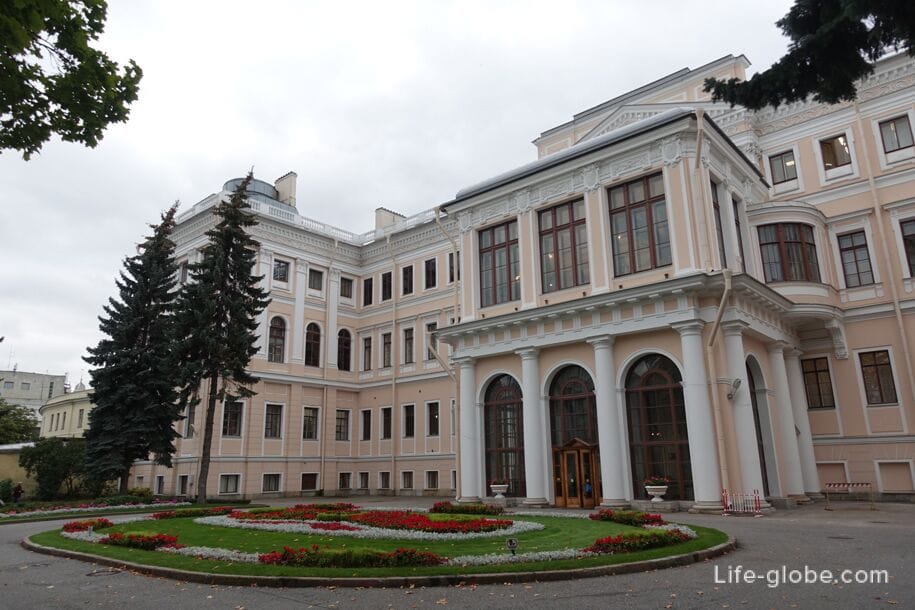
The building in the form in which we can see it today, was rebuilt for a large entrepreneur A.M. Ushakov (and his heirs) in 1882-1883, designed by P.Yu. Suzor.
The building has an eclectic facade, decorated with architectural elements, stucco, bay windows, semi-columns and pilasters with capitals.
Most of all, the building is known as the "Karl Bulla Photo Salon" - one of the oldest private photo salons in Russia, which was located in this house.
Today, the photo gallery houses the Karl Bulla Memorial Museum. More about the Karl Bulla House and Museum-photo salon…

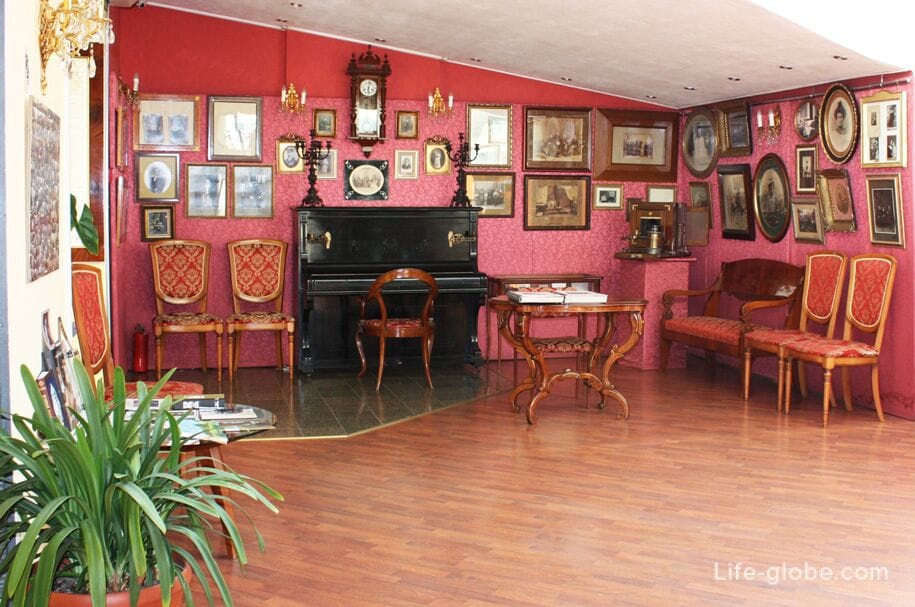
The building was built in 1902-1903 according to the project of the architect Gavriil Vasilyevich Baranovsky for the store of colonial goods of the trade association "Brothers Eliseev".
The style of the entire building is modern with elements of eclecticism and classicism.
The building has large windows and powerful pylons, and its facades are decorated with sculptures, plant elements, ornaments and openwork lattice.
Today, within the walls of the building are located: the shop of merchants Eliseev with an elegant interior and a small coffee shop, as well as the Comedy Theater named after N. P. Akimov. Read more about the merchant Eliseev store…
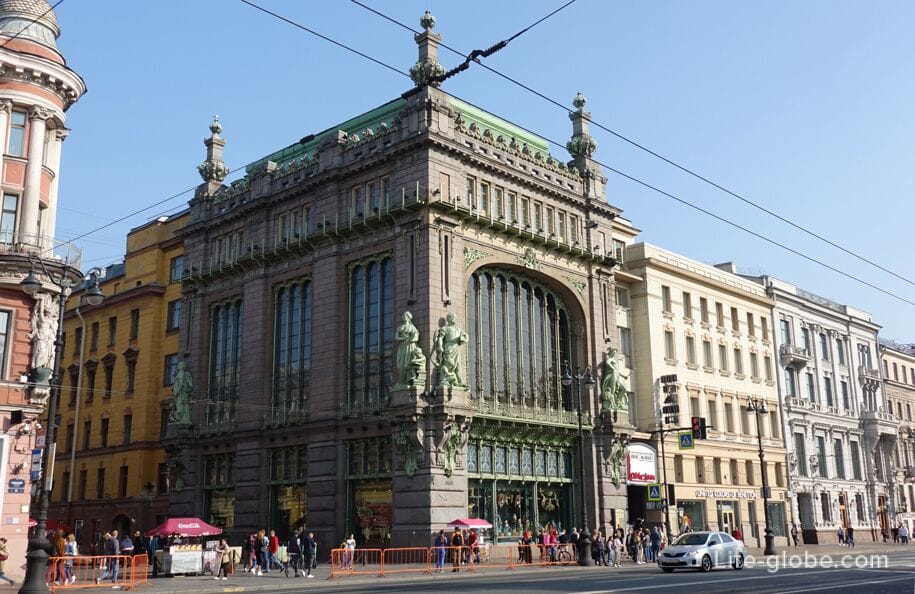

Anichkov Bridge is one of the most famous bridges in St. Petersburg.
The bridge is designed for the movement of vehicles and pedestrians. It runs through the Fontanka River and is part of Nevsky Prospekt.
The design of the Anichkov Bridge, which can be seen today, was born in 1841 according to the project of engineer Major Ivan Fedorovich Buttats.
The bridge is decorated with four recognizable sculptural compositions - "The Taming of the horse by man" or simply "The Taming of the Horse", which are installed on both sides of the bridge on granite monumental pedestals. Learn more about the Anichkov Bridge…
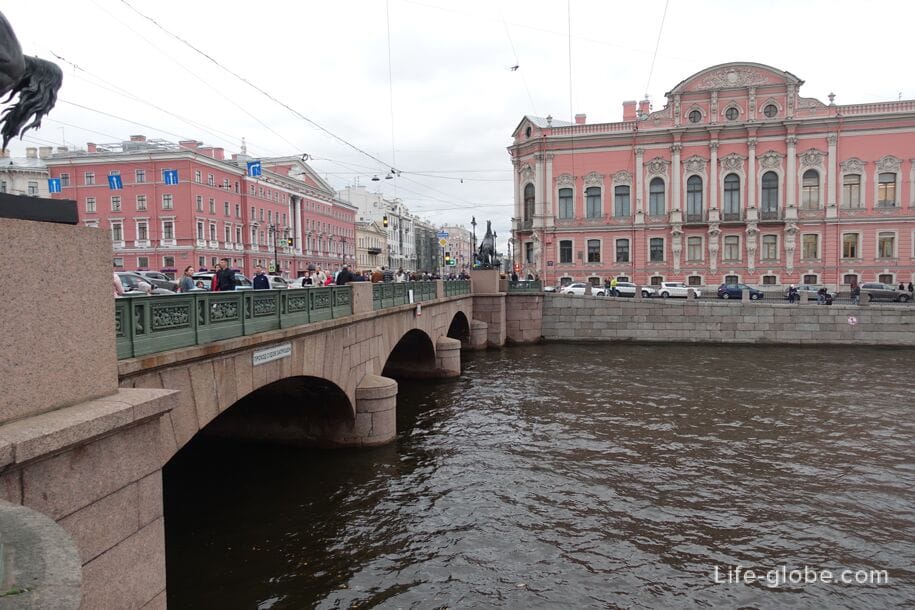
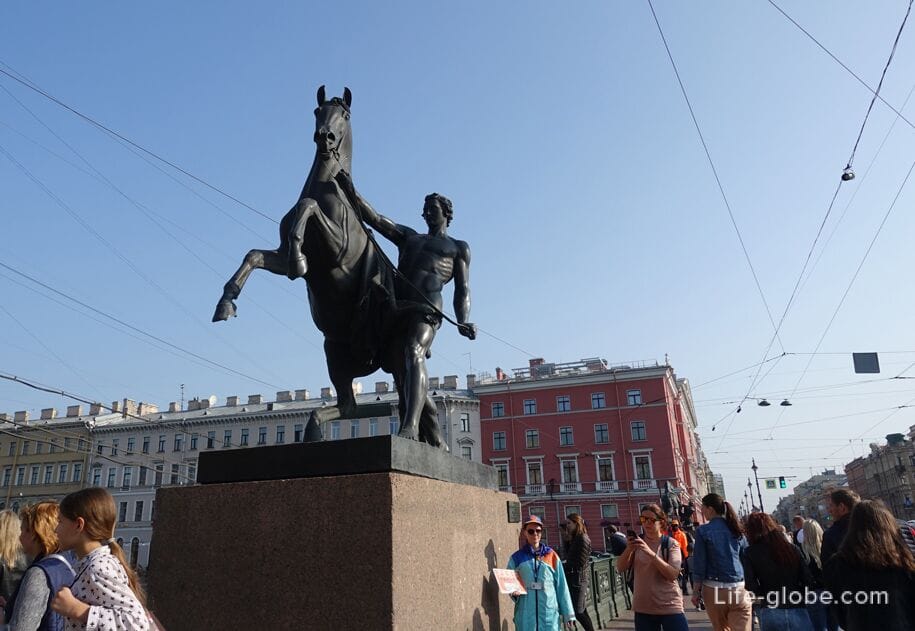
The Beloselsky-Belozersky Palace (Sergievsky) is a former mansion and a monument of architecture in the New Baroque style.
The palace was built in 1847-1848 by order of Prince Esper Alexandrovich Beloselsky-Belozersky.
Since 1884, the palace was owned by Grand Duke Sergei Alexandrovich-the younger brother of Alexander III. Hence the second name of the palace - "Sergievsky".
Today, the Beloselsky-Belozersky Palace attracts attention with its bright color, columns with capitals, architectural decorations of window openings and large figures at the level of the first floor.
The palace is a place of culture - within its walls there is a museum, guided tours of the preserved interiors, as well as concerts, conferences, presentations and photo shoots. More about the Beloselsky-Belozersky Palace…
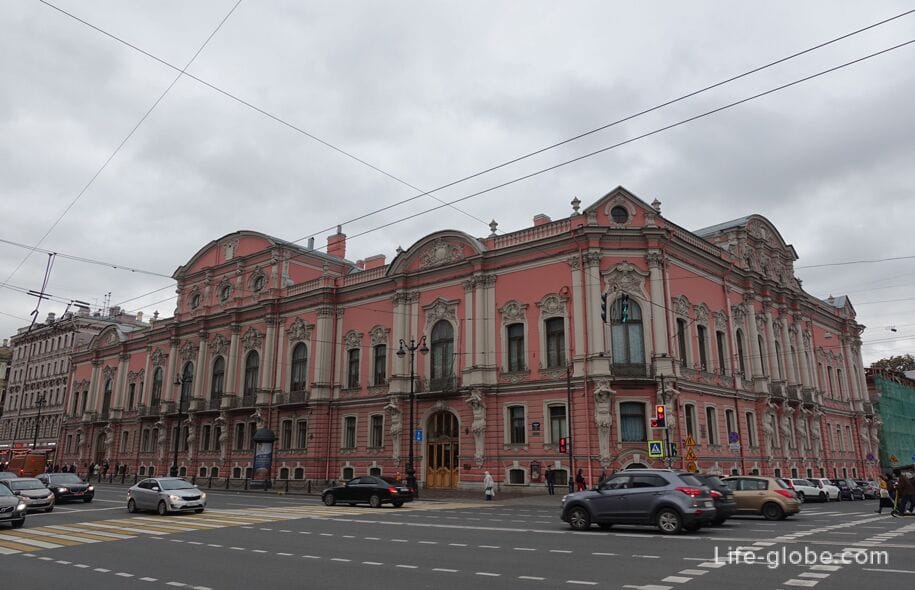
The four-story building on the site of the previous buildings was erected in 1839-1840, designed by architect Vasily Yegorovich Morgan. After its construction, the building became one of the largest apartment buildings in the capital - apartments were rented out in it.
After that, the building changed owners. In the 19th century, the house was inhabited by famous writers of that time, which gave the building its second name - "Literary House".
During the Great Patriotic War, part of the building was destroyed. After the reconstruction.
In 2011, due to accidents, the building was demolished, and then (2015) recreated with the addition of one floor and a repeat of the Soviet facade of the mid-20th century.
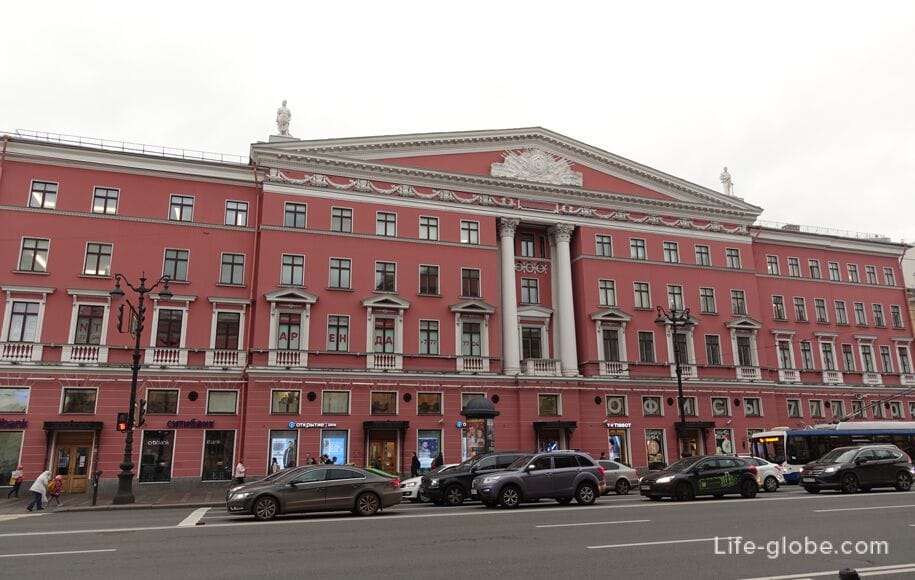
Initially, there was a two-story house on this site, which in 1829 was built on one floor by architect A.D. Nellinger. Then the plot was owned by a court dancer, choreographer and head of the Theater School Sh.L. Didlo.
In 1899, the house was purchased by Grand Duke Sergei Alexandrovich, who owned the nearby Beloselsky-Belozersky Palace. For the new owner, the architect A.V. Kashchenko in 1900, the house was built on two more floors and its facades were redesigned in a Baroque form, in order to connect it architecturally with the neighboring palace.
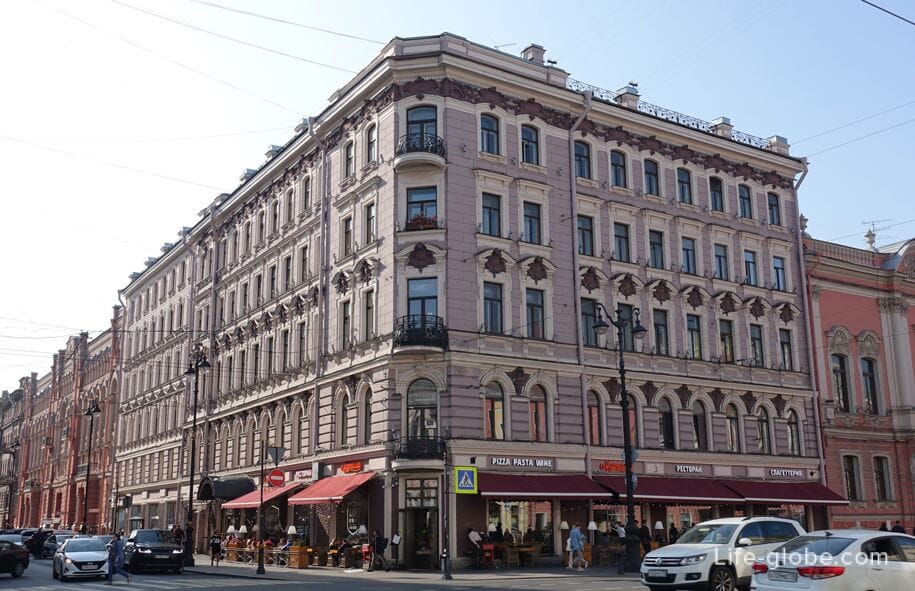
The house is also known as the Moscow Hotel.
The first house on this site was built in the late 18th century. In the 1850s, the merchants of Rotina opened a hotel and restaurant in the building, which became known as"Moscow". In 1880-1881, the architect P. Yu. Syuzor, commissioned by the new owner of the building - merchant A.M. Ushakov, carried out the reconstruction of the four-story building in the eclectic style, including the decoration of the facades with rust chains and stucco details.
A large-scale reconstruction of the building was carried out in 1999-2001. After that, and to this day, the 5-star Radisson Royal Hotel is located within the walls of the building with a fitness center, a spa center with a sauna, a hot tub and a massage room.
A buffet breakfast or an American breakfast can be included in the room rate. Children under 5 years old can enjoy breakfast free of charge. Link to the hotel
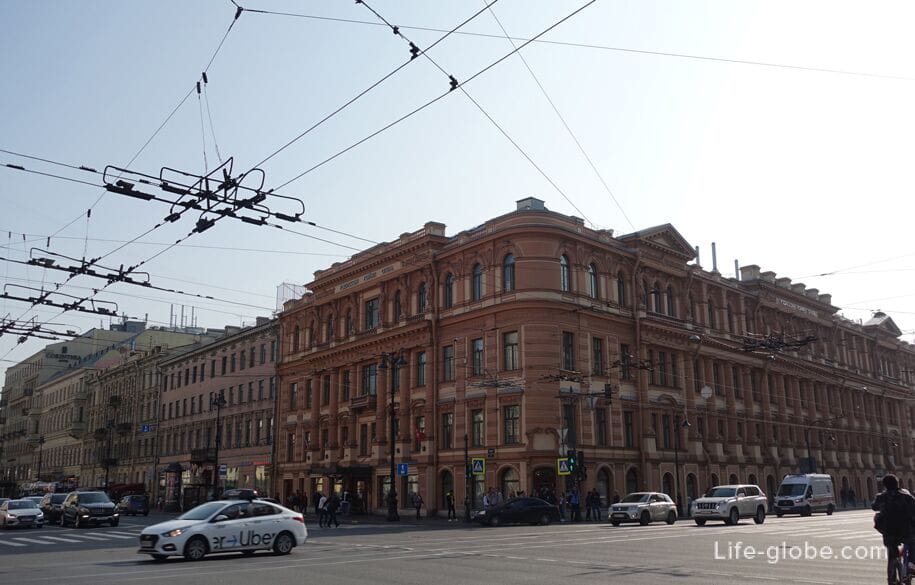
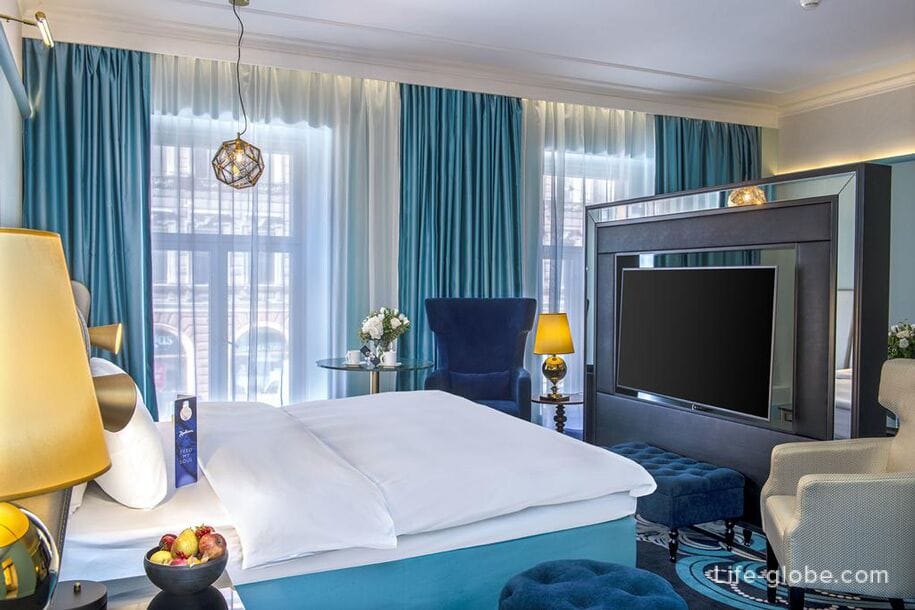
The building is also known as the Actor's House (or the Benardaki house, or the Yusupov House), and is one of the most beautiful buildings on this section of Nevsky Prospekt.
The building was rebuilt from a building previously located on this site by 1820, designed by architect M. A. Ovsyannikov for the owner-Colonel F. N. Petrovo-Solovovo. Then the building acquired the existing classical appearance with a six-column portico in the middle.
In 1835, the building was added to the side wings and enriched with decoration on the facades for Count Branicki, designed by G. Fossati. Concerts and exhibitions were held in the Branicki mansion.
In the 1840s, the house was owned by Kalugin. Later, it was owned by a Greek, lieutenant and rich winemaker Dmitry Yegorovich Benardaki, who had a garden with a gazebo-stage in the courtyard of the house and built residential buildings in the depth of the plot.
By 1877, the house was purchased by the chamberlain Prince N. B. Yusupov, who began to use it as a room for exhibitions and social receptions.
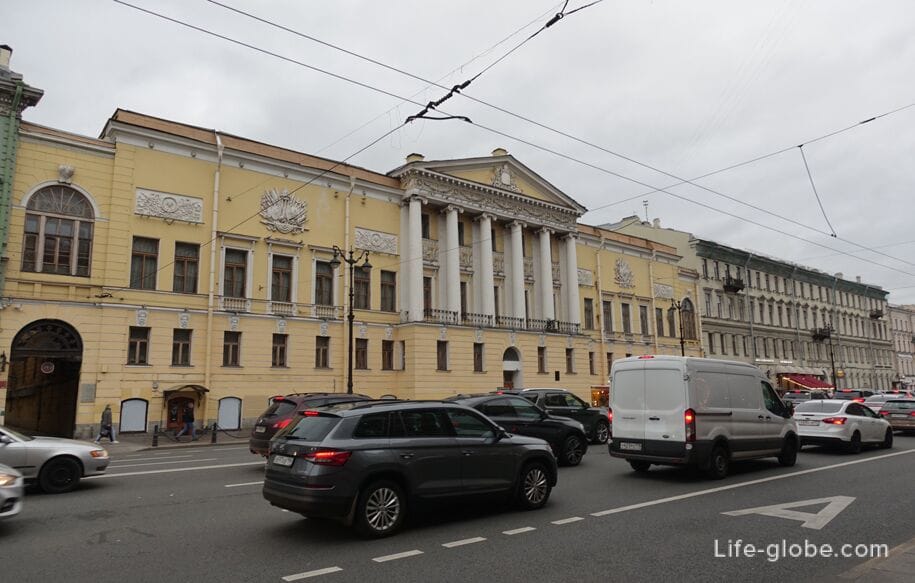
The original building on this site was built in the late 18th and early 19th centuries and had two floors. Until 1854, the building was owned by the State Councilor, the president of the Medical and Surgical Academy, J. V. Willie. In the 1860s, the building passed to a new owner - his wife V. I. Willie.
In 1872, the house was purchased by the court councilor I. F. Alexandrovsky, for whom in 1875-1876 the architect P. Yu. Syuzor built courtyard wings; and after the same architect built the main building with the third and fourth floors and decorated the facade in the eclectic style. The mezzanine with a dome was supposed to remind of the Parisian architecture of the 17th and 18th centuries. The putti figures on the mezzanine have a special charm.
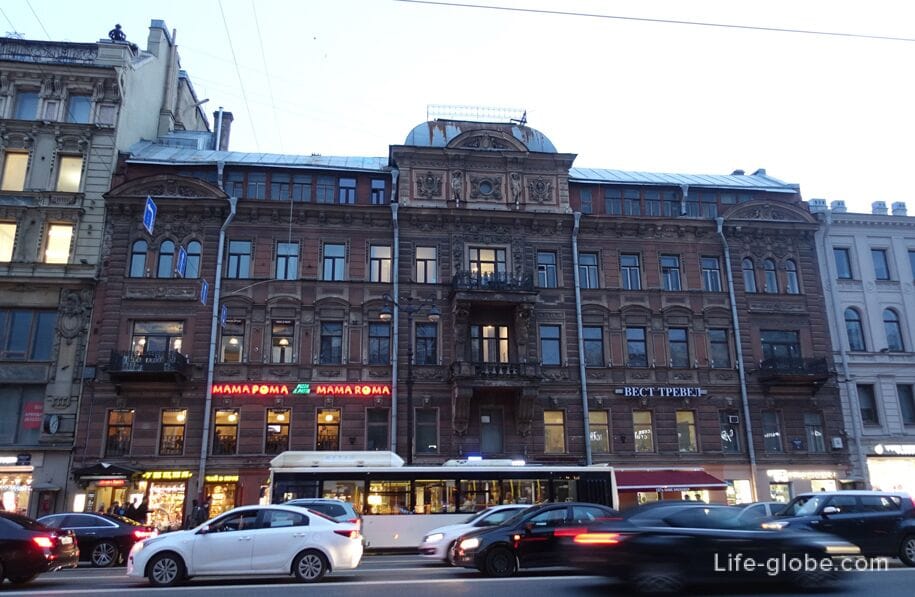
The house on this site has existed since the 1820s and has changed several owners.
In 1902-1904, a new building was built on this site for the Turkish citizen banker G. G. Blokka. The author of the project was the architect L. L. Fufaevsky, who included the walls of the old house in the new structure. The facade of the building was decorated in an eclectic style.
Subsequently, the building changed owners, and its premises were used for various purposes.
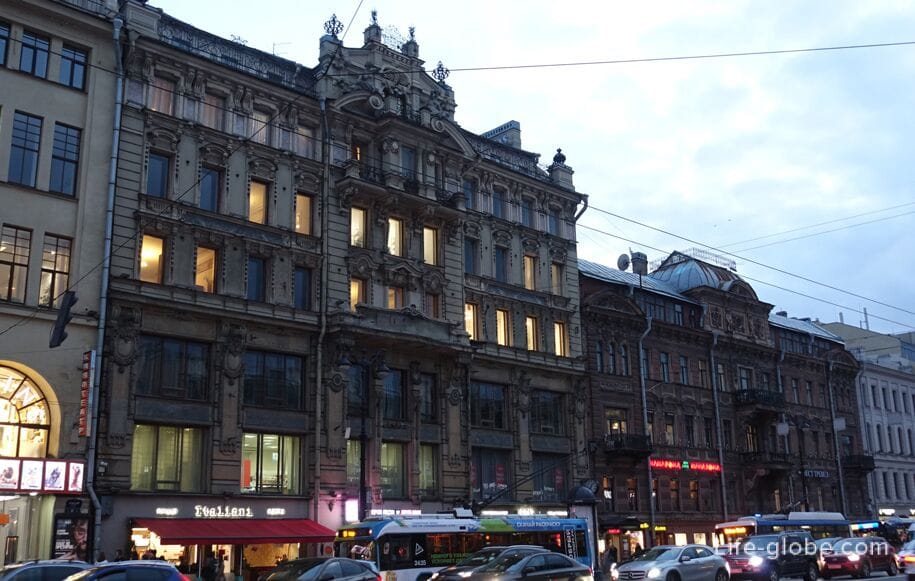
The three-story house was built for the adviser of the State Military College V. A. Pashkov by 1798.
At the beginning of the 19th century, the house was purchased by the Yakovlev family of merchants. In 1838 or 1839, for I. T. Yakovlev, the architect A. H. Pel added a fourth floor to the building and erected two courtyard wings.
In 1871, Makarov rebuilt the building, while richly decorating its facade, which became saturated with stucco eclectic decorations. In addition to the rich decorations, the building stands out with a wide risalit with rounded corners and a mezzanine with putti figures.
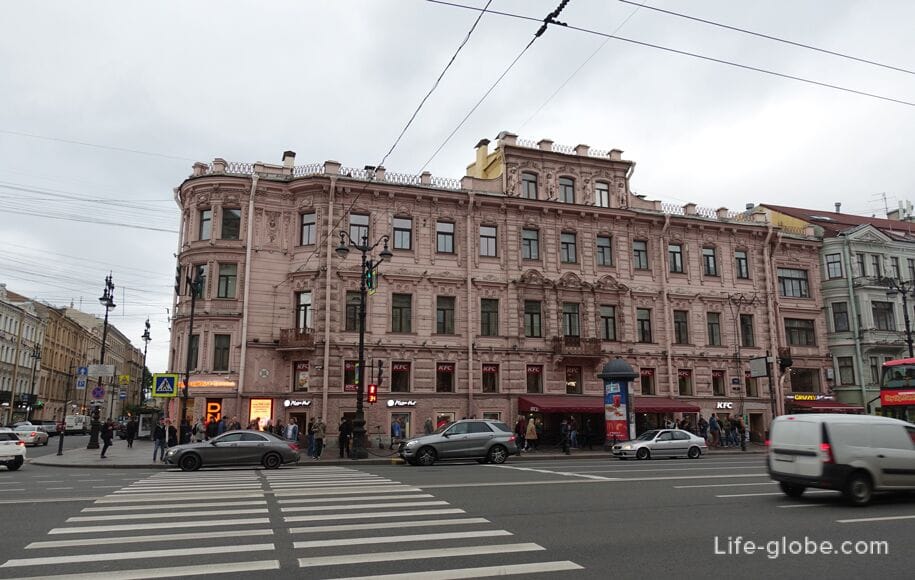
Initially, this place was a two-story stone house. In 1837, the architect A. I. Melnikov built it on the third floor and built courtyard wings. The customer of this work was the merchant's wife A. Durdin.
In 1873-1874, for the merchant A. E. Shlyakov, the architect V. M. Nekora added two more floors to the house and redesigned the facade in the eclectic style.
In 1913, the architect A. G. von Bock converted the left windows of the first two floors into wide showcases, the piers between which were faced with granite.
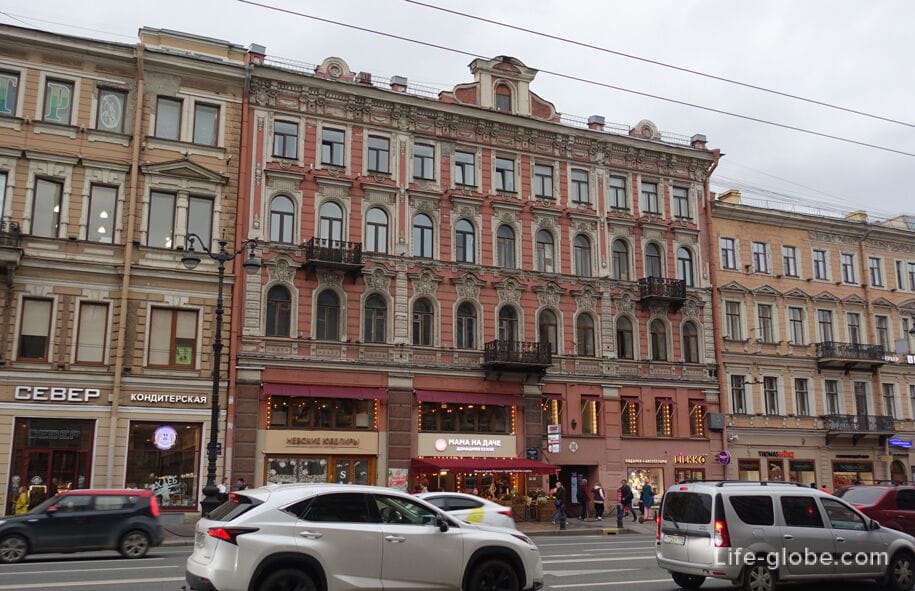
These are corner houses of the same type, which are separated by Pushkinskaya Street.
In the first half of the 19th century, the plot belonged to the merchant Lopatin.
Since 1874, both corner houses were purchased by the Maltsev family. For the owners, architect P.Y. Syuzor built symmetrical apartment buildings that included the walls of old buildings.
From the Maltsevs, both sections passed to Adjutant General P. A. Shuvalov, and in 1908 to his son A.P. Shuvalov.
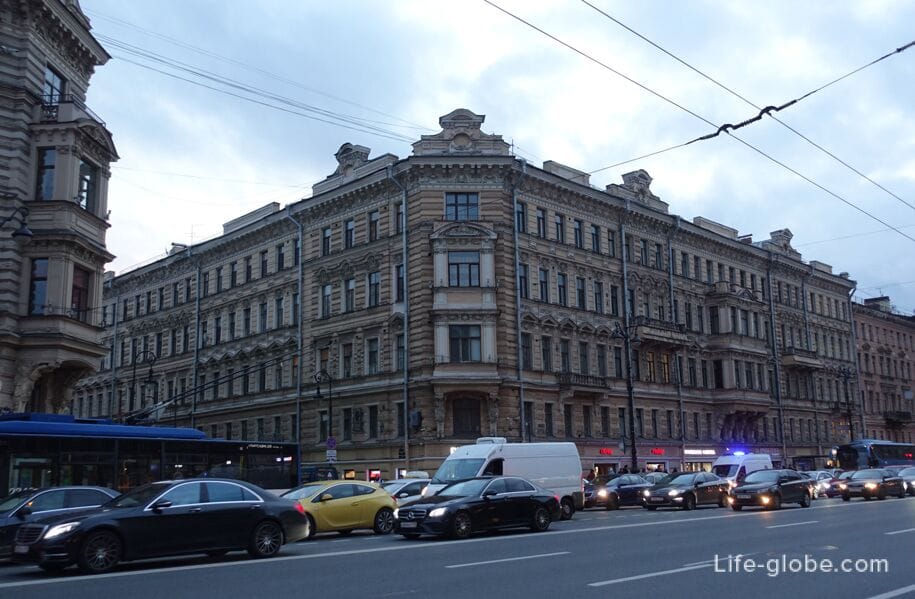
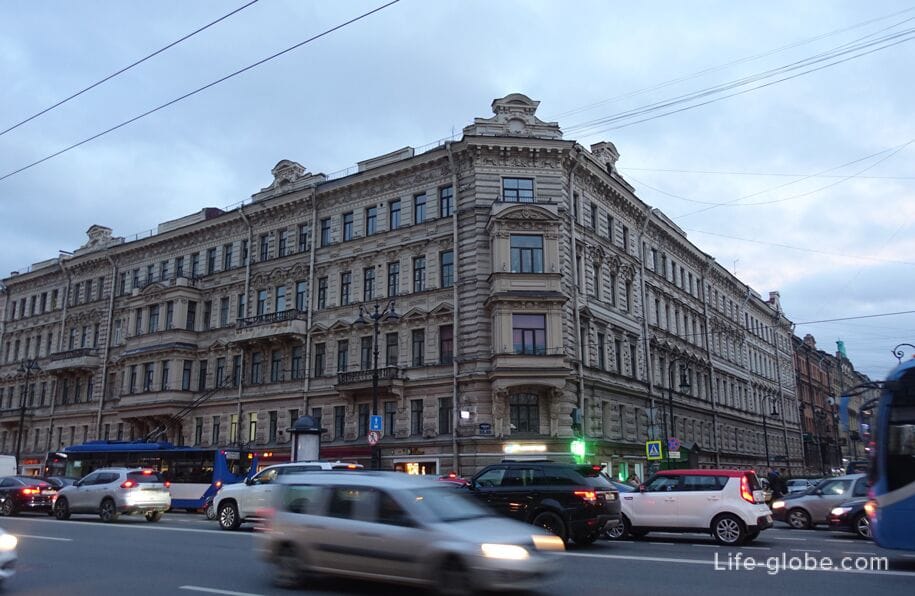
Vosstaniya Square is one of the central and most famous squares in St. Petersburg.
The center of the square is decorated with a high obelisk "To the Hero City of Leningrad", and along the perimeter there are historical buildings, including the ground pavilion of the same name of the metro station and Moskovsky railway station. Learn more about Vosstaniya Square…
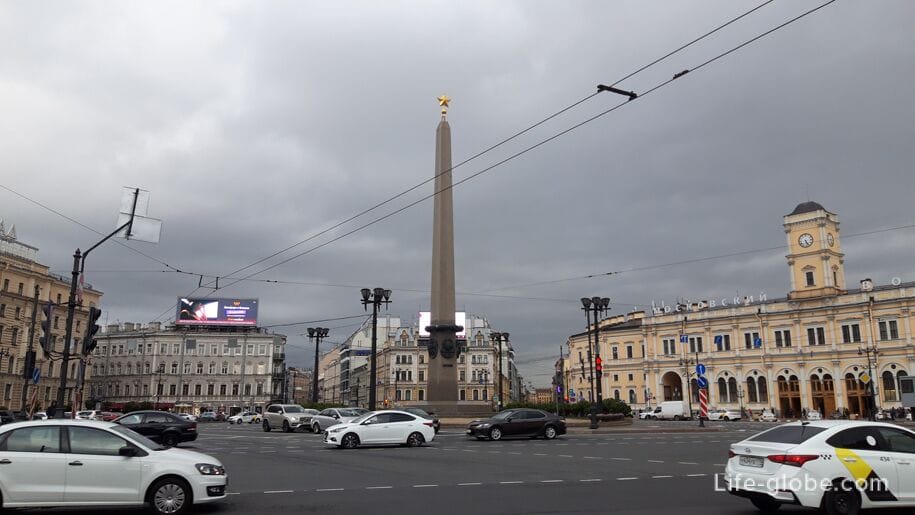
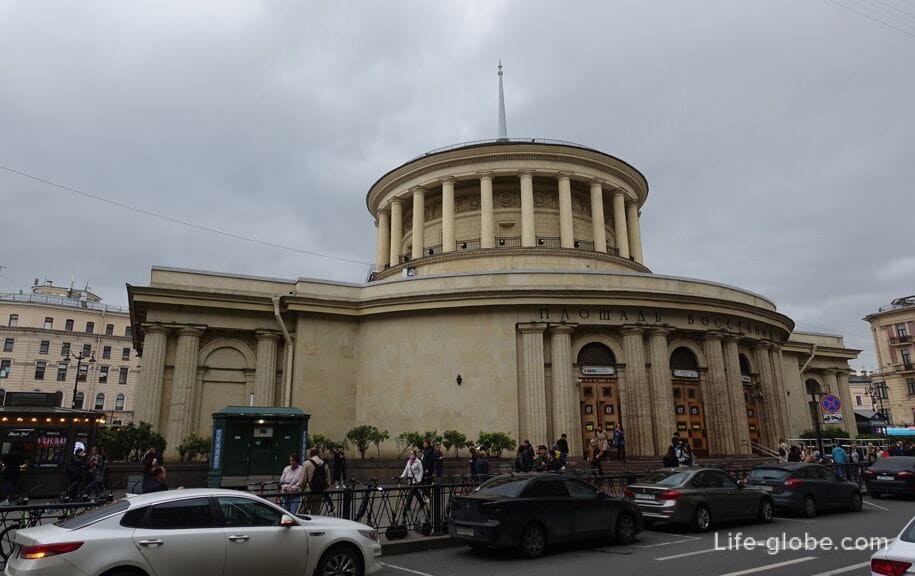
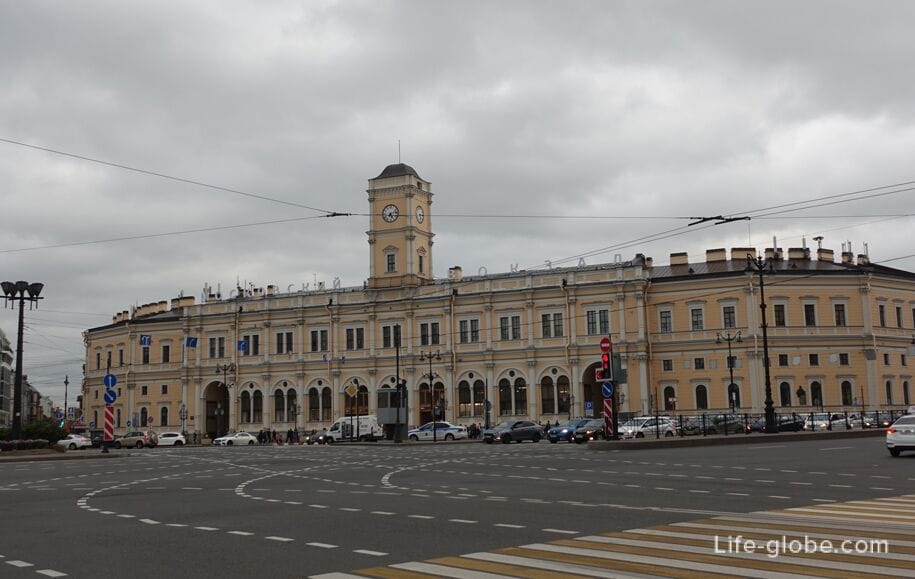
On the opposite side from the Moscow Railway Station, Vosstaniya Square is decorated with the building of the Oktyabrskaya Hotel, which is considered one of the oldest in St. Petersburg.
The hotel was built in 1845-1857 by the architect A. P. Gemilian. In the future, the building was rebuilt.
Initially, the hotel was called "Znamenskaya", then - "Severnaya" and "Bolshaya Severnaya", and after the revolution it became known as "Oktyabrskaya".
Today it is a functioning 4-star hotel Oktyabrskaya with a bar, a restaurant, free Wi-Fi, a 24-hour front desk, a fitness center, a beauty salon, conference rooms and meeting rooms.
Breakfast can be included in the room rate. Link to the hotel
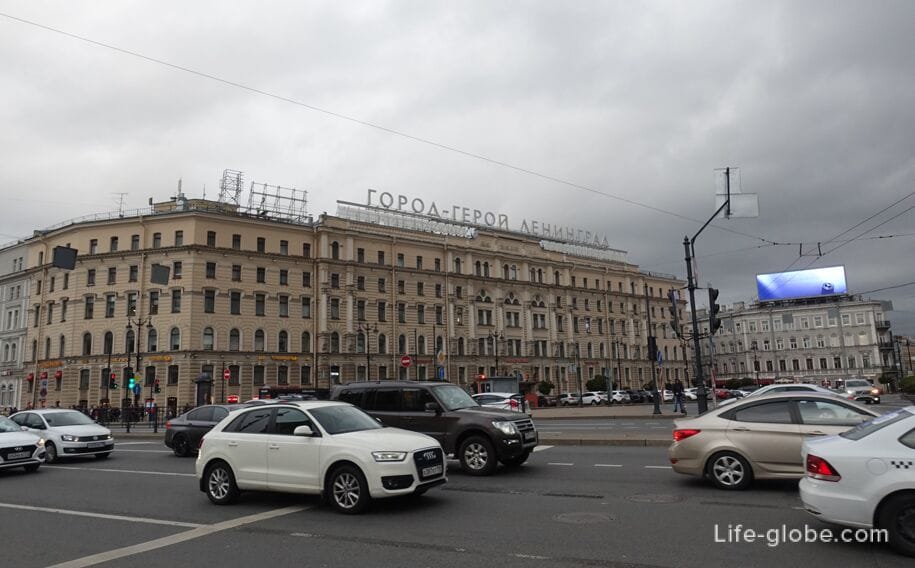
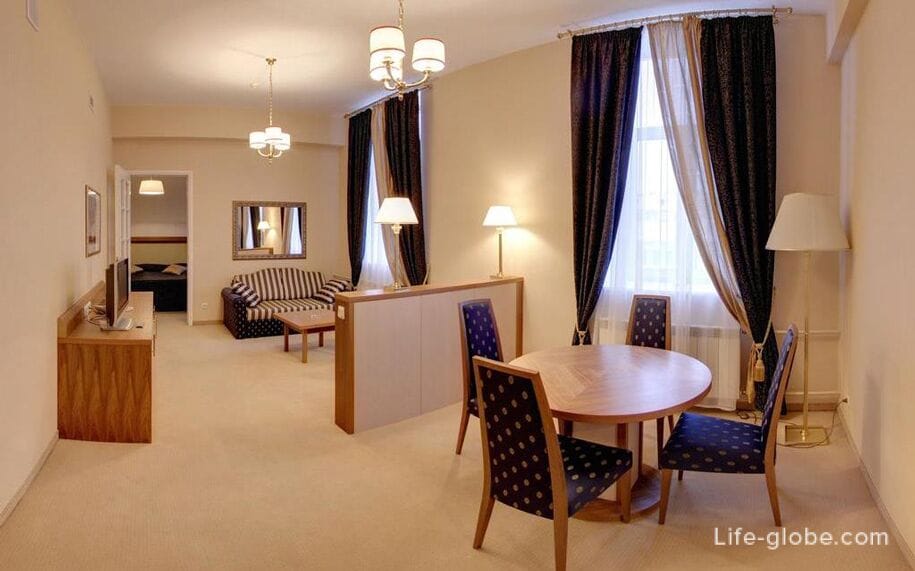
In 1890-1907, the plot belonged to the hereditary honorary citizen Andrey Kirillovich Savin and his wife Evdokia Timofeevna.
In 1901-1902, the architect Alexander Sergeyevich Khrenov built a five-story apartment building and three-story stone wings along the rear border of the courtyard, and he also gave the corner part of the building (Nevsky Prospekt and Degtyarnaya Street) a characteristic appearance for his work with a round bay window completed with a decorative tower.
The premises of the first floor of the building were intended and are intended for retail premises and are equipped with rectangular display windows; the semicircular windows of the third floor are decorated with an ornamental cornice-belt.
The architectural style of the building is eclectic.
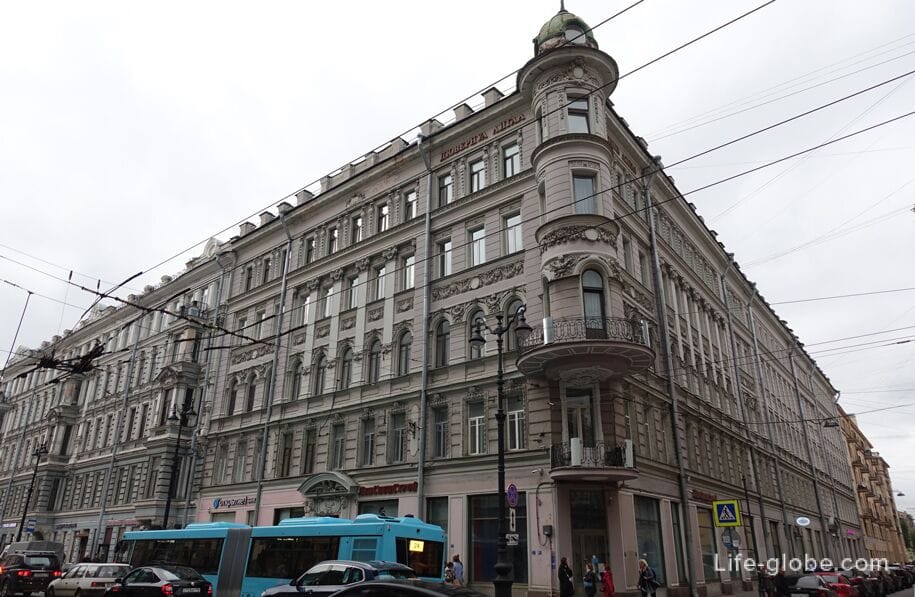
The house was built in 1877-1880 by the architect Alexander Vasilyevich Ivanov.
In 1900, the building was expanded by D. A. Kryzhanovsky.
The house has an eclectic style and the rounded facade of the building faces Nevsky Prospekt. Also attention is drawn to the massive bay windows and the abundance of decor on the facades.
Today, the buildings include: the 4-star Galunov Hotel with free Wi-Fi, free private parking, a 24-hour front desk and breakfast included in the room rate; the 3-star FILIPPOV rooms Hotel with a 24-hour front desk, a shared kitchen, free Wi-Fi and private parking.
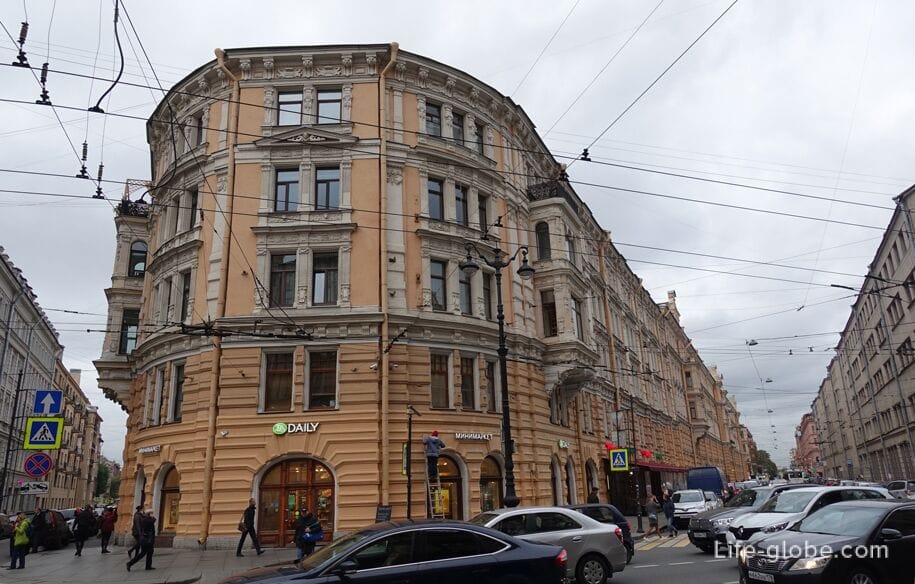
The house was built in 1878-1880 by the architect Grigory Alexandrovich Solovyov, for merchants Dmitry and Fyodor Lavrentievich Parfenov, who made money on the sausage trade.
With the construction of this house, the Parthenovs began investing in real estate. After the construction was completed, the house was sold to Ivan Evstafyevich Ivanov, a member of the charity society of the Borisoglebskaya Church, the owner of the material yards.
The five-story corner building is designed in an eclectic style.
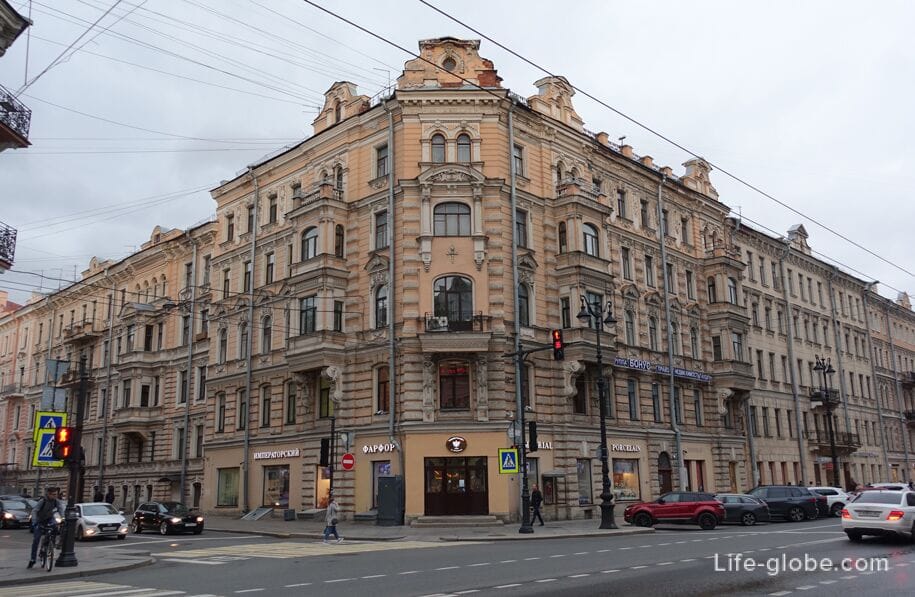
The house was built on the site of the former buildings in 1897-1898 by the academic architect Pavel Yulyevich Suzor for the merchant of the 1st guild of the brick breeder Ivan Pavlovich Porshnev and the grain merchant Wulf Mordukhovich Davidov.
After Porshnev's death in 1907, he became the sole owner of the building and settled in the House of Davids.
The five-story building is angular, designed in the eclectic style. It is distinguished by a rounded corner with a domed roof; it also has balconies, bay windows and facade decorations.

The apartment house of I. I. Kruglov was built in 1905 according to the project of the civil engineer Pyotr Nikolaevich Batuev.
The house is designed in the Art Nouveau style, and its corner is rounded.
In the left front door (entrance) on the windows of the stairwells there are remnants of stained glass windows.
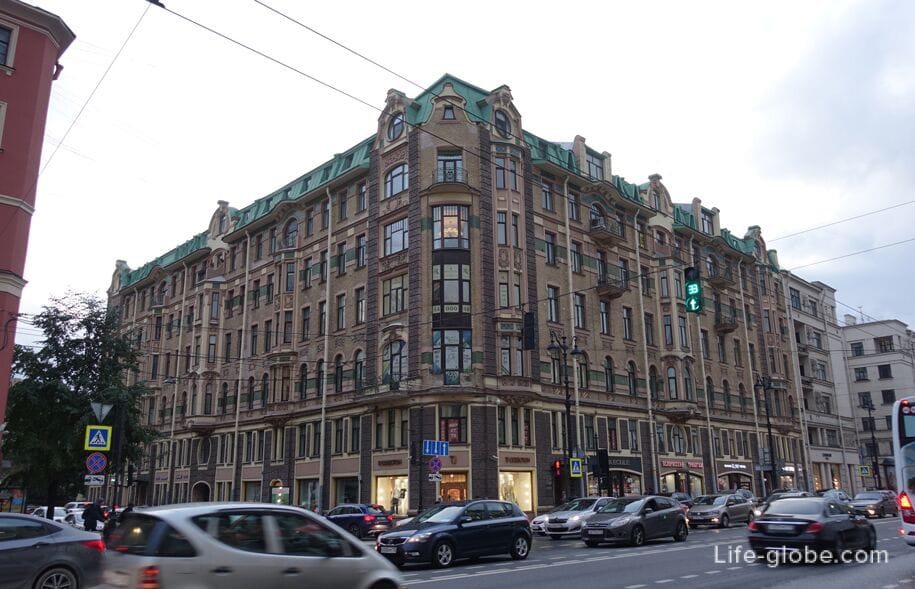
The end of Nevsky Prospekt marks Alexander Nevsky Square, the center of which is decorated with a monumental equestrian monument to Grand Duke Alexander Nevsky, installed in 2002-the 300th anniversary of St. Petersburg.
On the square there are metro stations "Alexander Nevsky Square". Learn more about Alexander Nevsky Square and metro stations…
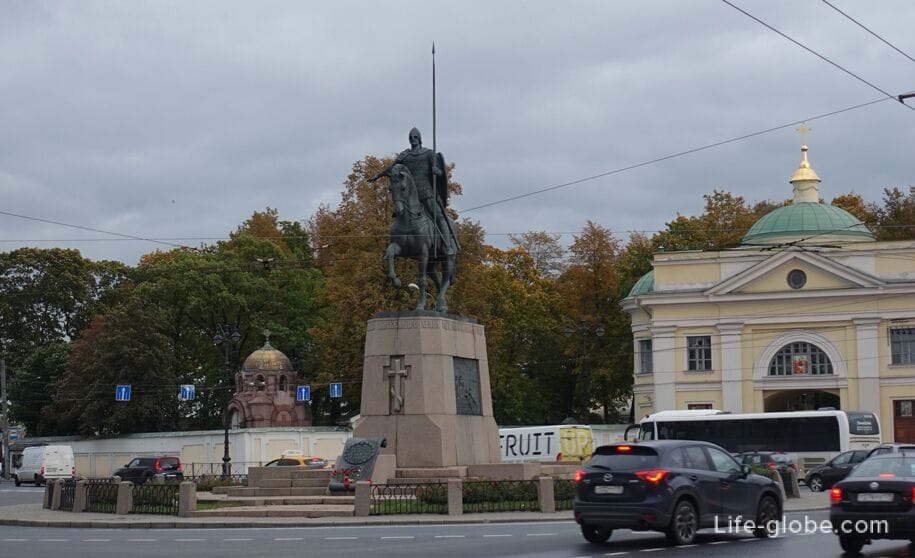
On the north-eastern side of the square stands a shopping center and a hotel - the 4-star Hotel Moscow, some rooms of which offer views of the Neva River and the Alexander Nevsky Lavra.
The seven-storey building of the hotel was built in 1974-1979 according to the project of the group under the leadership of D.S. Goldgor. In 2005-2007, the building was reconstructed according to the project of architects V.M. Freifeld and D. B. Sedakov, as a result of which the facades were changed, the building received an attic floor, and inside, in addition to the hotel, there is also a shopping center.
In the hotel: restaurants, including panoramic restaurant beef bar, free Wi-Fi, spa and wellness center, private Parking. On the floors there are coolers with hot and cold drinking water.
Each roomhere will provide you with a refrigerator, air conditioning, a free safety deposit box and free toiletries. Most rooms have an electric kettle.
Breakfast is included in the room rate. Link to the hotel

From Alexander Nevsky Square begins a monumental and voluminous monastic complex - The Holy Trinity Alexander Nevsky Lavra is a male Orthodox monastery, which was founded in 1710 and dedicated to the holy Prince Alexander Yaroslavich Nevsky, and which was granted the status of a Lavra in 1779.
Today, the monastery complex includes: the Holy Trinity Cathedral, the Alexander Nevsky Church and several other churches, cemeteries (now necropolises), buildings for various purposes, including monastic buildings, as well as a garden, monuments and museums.
Entrance to the territory of the complex, to the Holy Trinity Cathedral and churches is free (free of charge). The fee is charged for visiting the hotel museums located on the territory of the Lavra. Read more about the Holy Trinity Alexander Nevsky Lavra…
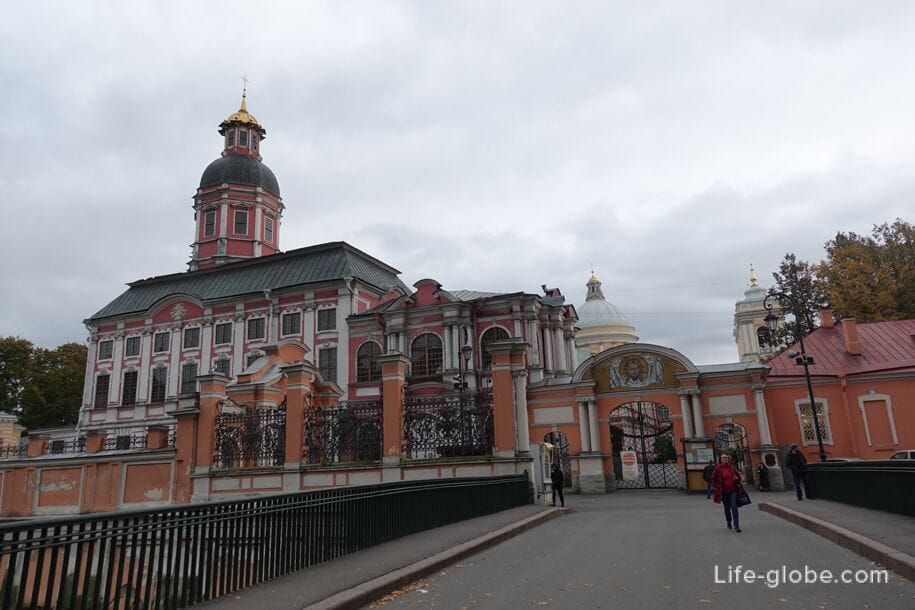
Metro stations on Nevsky Prospekt and near the avenue: "Admiralteiskaya", "Nevsky Prospekt", "Gostiny Dvor", "Mayakovskaya", "Ploshchad Vosstaniya" and "Alexander Nevsky Square".
Public buses and trolleybuses run along Nevsky Prospekt and near the avenue.
You can visit Nevsky Prospekt either on your own or with one of the city tours
All accommodation facilities in St. Petersburg, including in the city center and on Nevsky Prospekt, can be viewed and booked here